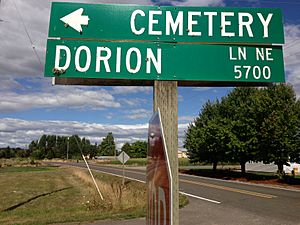Marie Aioe Dorion facts for kids
Quick facts for kids
Marie Dorion
|
|
|---|---|

Dorion historic marker outside St. Louis Catholic Church
|
|
| Born | Probably 1786 |
| Died | September 5, 1850 (aged 63–64) |
| Known for | Assisting fur-trading expeditions in the Pacific Northwest; wilderness survival skills |
| Spouse(s) | Pierre Dorion Jr., Louis Joseph Venier, Jean Baptiste Toupin |
| Relatives | Five children |
Marie Dorion (around 1786 – September 5, 1850) was an amazing woman. She was the only female member of a long journey across land. This trip was organized by the Pacific Fur Company in 1810. It explored the Pacific Northwest.
Marie was Métis, just like her first husband, Pierre Dorion Jr.. Her mother was from the Iowa people, and her father was French Canadian. She was also known as Marie Laguivoise. This name was written down in 1841 at the Willamette Mission. It seems to be a different way of saying Aiaouez, which later became Iowa.
Contents
Marie Dorion's Early Life and Connections
It's possible that Marie Dorion and Sacagawea knew each other. Both women lived in the small town of St. Louis. They were also married to people who helped translate for fur traders. This connection shows how important women were in these early American adventures.
Adventures in the Pacific Northwest
Marie Dorion's first husband, Pierre Dorion Jr., was hired by the Pacific Fur Company. He joined a group led by Wilson Price Hunt on a journey to Fort Astoria. Marie went with them, bringing their two young sons. The boys were probably two and four years old.
A Difficult Journey West
During the trip, Marie gave birth to another child. This happened near what is now North Powder, Oregon. Sadly, the baby lived for only a few days. After reaching Fort Astoria, Marie and her family went with a group of trappers. They traveled to the Snake River area.
Surviving a Dangerous Attack
In January 1814, Marie was at a trading post. A scout told her that her husband's trapping party was in danger. They were about to be attacked by a group of Bannocks. Marie bravely traveled alone for three days with her two young children. She found the place where the attack happened.
Only one trapper, LeClarc, was still alive. Marie helped him move away from the dangerous area on a horse. She tried to help him with his injuries, but he passed away that evening.
Marie's Incredible Survival Skills
The Bannock warriors had left several horses behind. Marie quickly took them back to the small fur trading post. But when she arrived, she found that the few people there had also been killed. Marie decided to try and reach another safe fur trading station.
One of her two horses collapsed in the Blue Mountains. This left Marie and her two children stranded during winter. She supported her two young sons for 50 days. Marie made snare traps from horse hair to catch mice and squirrels for food. She also smoked the horse meat to preserve it. She gathered frozen berries and ate the inner bark of trees. These skills kept her family from starving.
Finding Help and New Beginnings
Near the end of March, Marie was able to move west again. She finally reached a Walla Walla village. She was very tired and had little food left. The village leaders helped her and gave her supplies. They also helped her get back to Fort Astoria.
After these adventures, Marie married two more times. Her second husband was Louis Venier. With her third husband, Jean Toupin, she settled near Saint Louis, Oregon. This area was known as the French Prairie. It was here that people started calling her "Madame" or "Madame Iowa." One of her older sons, Jean Baptiste, joined the Oregon Rifles. He fought in the Cayuse War.
Marie Dorion's Legacy
Marie Dorion passed away on September 5, 1850. She was buried inside the first log Catholic church in Saint Louis. In 1880, the church burned down, and a new one was built. After that, no one remembered where Marie's grave was. It is still unknown today.
Many years later, the church records were translated from French to English. That's when people learned Marie had been buried inside the church. We don't know why she received this special honor. Being buried inside a church usually required special permission. This might mean Marie was a very religious person.
Honoring Marie Dorion Today
Many places remember Marie Dorion. There are two parks named after her. Madame Dorion Memorial Park is near the Walla Walla River in Wallula. Marie Dorion Park is a city park in Milton-Freewater, Oregon. It is near the Blue Mountains.
The Dorion Complex residence hall at Eastern Oregon University in La Grande is also named for her. There is a special plaque near North Powder where she likely gave birth. Marie Dorion's name is also among 158 important people in Oregon's history. Their names are painted in the House and Senate chambers of the Oregon State Capitol. Her name is in the Senate chamber. In St. Louis, Oregon, there is a street named Dorion Lane.
Oregon author Jane Kirkpatrick wrote a series of historical novels about Marie Dorion's life. The series is called Tender Ties. The books are A Name of Her Own, Every Fixed Star, and Hold Tight the Thread.
On May 10, 2014, the Daughters of the American Revolution held a ceremony. They placed a historical marker in Marie Dorion's honor at Saint Louis Catholic Church.


